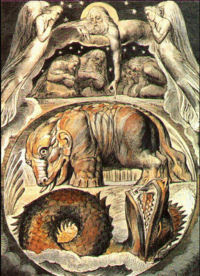Behemoth

For other uses, see Behemoth (disambiguation).
Behemoth is a creature mentioned in the Book of Job, 40:15-24. In Hebrew it can be rendered as בהמות, Bəhēmôth, Behemot, B'hemot; in Arabic بهيموث (Bahīmūth) or بهموت (Bahamūt) .
The word is most likely a plural form of בהמה (bəhēmāh ("animal")). It may be an example of pluralis excellentiae, a Hebrew method of expressing greatness by pluralizing a noun; it thus indicates that Behemoth is the largest and most powerful animal.
Metaphorically, the name has come to be used for any extremely large or powerful entity.
Contents[hide]
1 Characteristics
2 Meaning
3 Other cultures
4 See also
5 Notes
6 References
7 External links
//
[edit] Characteristics
The text from the Book of Job 40 (King James Version Bible) is as follows:
15 Behold now behemoth, which I made with thee; he eateth grass as an ox.16 Lo now, his strength [is] in his loins, and his force [is] in the navel of his belly.17 He moveth his tail like a cedar: the sinews of his thighs are wrapped together.18 His bones [are as] strong pieces of brass; his bones [are] like bars of iron.19 He [is] the chief of the ways of God: he that made him can make his sword to approach [unto him].20 Surely the mountains bring him forth food, where all the beasts of the field play.21 He lieth under the shady trees, in the covert of the reed, and fens.22 The shady trees cover him [with] their shadow; the willows of the brook compass him about.23 Behold, he drinketh up a river, [and] hasteth not: he trusteth that he can draw up Jordan into his mouth.24 He taketh it with his eyes: [his] nose pierceth through snares.
The passage describes a large powerful animal that appears to be herbivorous (40:15).
In Jewish belief, Behemoth is the primal unconquerable monster of the land, as Leviathan is the primal monster of the waters of the sea and Ziz the primordial monster of the sky.
There is a legend that the Leviathan and the Behemoth shall hold the battle of the end of the world. They shall kill each other and a huge number of other creatures in the epic battle. The two will finally kill each other, and the surviving men will feast on their meat. According to midrash recording traditions, it is impossible for anyone to kill a behemoth except for the person who created it, in this case the God of the Hebrews. A later Jewish haggadic tradition furthermore holds that at the banquet at the end of the world, the behemoth will be served up along with the Leviathan and Ziz.
[edit] Meaning
Behemoth can be interpreted as a mythical animal. However, some have attempted to identify it with real-life animals.
In the book of Job, both Behemoth and Leviathan are listed alongside a number of mundane animals, such as goats, eagles, and hawks, leading many Christian scholars to surmise that Behemoth and Leviathan may also be mundane creatures. Suggested animals include the water buffalo and the elephant, but the most common suggestion is the hippopotamus.[1] Some readers also identify a hippopotamus in Isaiah's bahamot negeb or "beasts of the south" (30:6). Indeed, one of the Russian words for hippopotamus is "behemoth," which does not carry the same mythical connotations in Russian. Although the animal's tail "moves like a cedar" (40:17), an unlikely description for any of these animals, "tail' could be a euphemism for an elephant's trunk. [2] Moreover, some suggest that "tail" is a euphemism for male genitalia. Support for this is based on another meaning of the Hebrew word "move" which means "extend" and on the second part of verse 17 describing the sinew around its "stones" (the Vulgate uses the word "testiculorum"].
Others disagree, pointing to the fact that Behemoth is called "chief of the ways of God" (40:19), indicating that it is not a mere animal.
Another proposal is that the Behemoth is a dinosaur. Some sort of sauropod is usually proposed since large sauropods had tails "like a cedar". Adherents to this viewpoint hold that it is more consistent with the literal application of the text. However, critics usually point out that according to paleontology, sauropods, unlike Behemoth, were tree-browsers that became extinct 65 million years ago, predating the appearance and rise of people or grasses. Additionally, opponents of this theory argue that the text is probably allegory at best.
There are modern rumors of a sauropodlike animal called Mokele-mbembe living in Africa. As both creatures are rumored to be dinosaurs, some believe that Mokele-mbembe and Behemoth may be one and the same.[citation needed]
[edit] Other cultures
The Hebrew behemoth is sometimes equated with the Persian Hadhayosh, as the Leviathan is with the Kar and the Ziz with the Simurgh.
[edit] See also
Behemoth in popular culture
Water buffalo incident
Akdamus
Behemoth (band)
Tarasque
Leviathan
[edit] Notes
^ Metzger & Coogan (1993) Oxford Companion to the Bible, p76.
^ Mitchell (1987)
[edit] References
Metzeger, Bruce M. (ed); , Michael D. Coogan (ed) (1993). The Oxford Companion to the Bible. Oxford, UK: Oxford University Press. ISBN 0-19-504645-5.
Mitchell, Steven, 1987. The Book of Job. San Francisco: North Point Press. Cited in R. T. Pennock, 1999, Tower of Babel, Cambridge, MA: MIT Press.
[edit] External links
Jewish Encyclopedia: Behemoth.
Putting God on Trial- The Biblical Book of Job contains a major section on the literary use of Behemoth.
Retrieved from "http://en.wikipedia.org/wiki/Behemoth"


Comments
Post a Comment